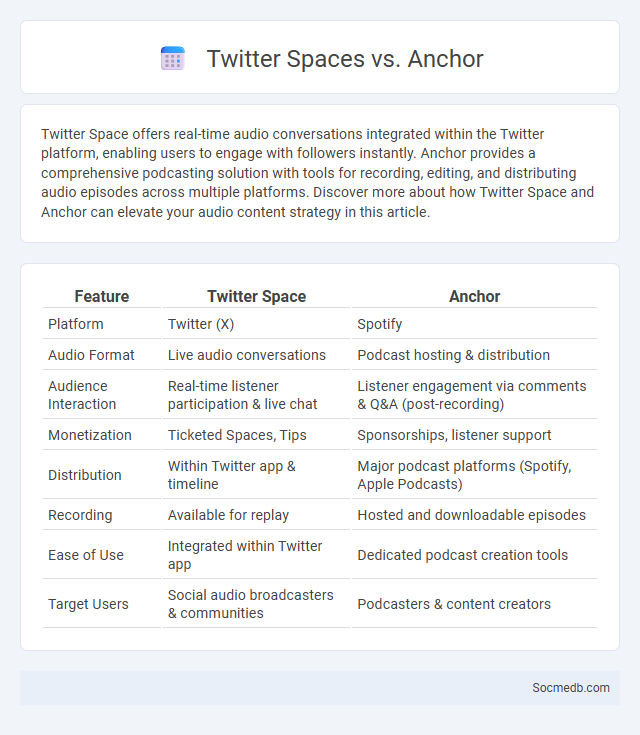
Photo illustration: Twitter Space vs Anchor
Twitter Space offers real-time audio conversations integrated within the Twitter platform, enabling users to engage with followers instantly. Anchor provides a comprehensive podcasting solution with tools for recording, editing, and distributing audio episodes across multiple platforms. Discover more about how Twitter Space and Anchor can elevate your audio content strategy in this article.
Table of Comparison
| Feature | Twitter Space | Anchor |
|---|---|---|
| Platform | Twitter (X) | Spotify |
| Audio Format | Live audio conversations | Podcast hosting & distribution |
| Audience Interaction | Real-time listener participation & live chat | Listener engagement via comments & Q&A (post-recording) |
| Monetization | Ticketed Spaces, Tips | Sponsorships, listener support |
| Distribution | Within Twitter app & timeline | Major podcast platforms (Spotify, Apple Podcasts) |
| Recording | Available for replay | Hosted and downloadable episodes |
| Ease of Use | Integrated within Twitter app | Dedicated podcast creation tools |
| Target Users | Social audio broadcasters & communities | Podcasters & content creators |
Introduction: Comparing Audio Platforms
Audio platforms like Clubhouse, Spotify Greenroom, and Twitter Spaces offer unique social media experiences centered on live voice conversations. These platforms emphasize real-time interaction, enabling users to join discussions, share ideas, and build communities based on audio content. Your engagement on these audio-centric social networks can enhance connection authenticity and diversify your digital communication strategies.
Overview of Twitter Space
Twitter Spaces is a live audio conversation feature integrated within the Twitter platform, enabling users to host and participate in real-time discussions. It supports interactive engagement through voice, allowing speakers and listeners to connect on various topics, from casual chats to professional panels. With capabilities like ticketed Spaces and co-hosting, Twitter Spaces promotes community building and fosters vibrant, dynamic conversations globally.
Overview of Anchor
Anchor is a powerful social media platform focused on podcast creation and distribution, enabling you to easily record, edit, and share audio content across major networks like Spotify and Apple Podcasts. It offers user-friendly tools such as episode scheduling, audience analytics, and monetization options to enhance your podcasting experience. By leveraging Anchor's seamless integration and scalability, your podcast can reach a broader audience with minimal technical overhead.
Overview of Space
Space exploration generates vast public interest showcased by active discussion and content sharing across major social media platforms like Twitter, Instagram, and TikTok. NASA, SpaceX, and other aerospace organizations leverage social media to provide real-time updates, livestream rocket launches, and engage directly with global audiences. The growing influence of social media in space outreach drives increased public awareness, STEM education, and commercial investment in space technologies.
Key Features Comparison
Social media platforms vary significantly in their key features, with Facebook offering extensive networking capabilities and detailed user profiles, Instagram emphasizing visual content sharing through photos and stories, and Twitter prioritizing real-time updates via concise tweets. TikTok distinguishes itself with algorithm-driven short-form video content, fostering high user engagement, while LinkedIn focuses on professional networking and industry-specific content sharing. Understanding these unique features helps users select platforms that best match their communication style and content preferences.
Audience Engagement and Interaction
Maximizing audience engagement on social media involves creating compelling content that resonates with your target demographic and encourages active participation. You can foster meaningful interaction by responding promptly to comments, asking open-ended questions, and leveraging interactive features like polls and live videos. Consistently analyzing engagement metrics helps refine strategies to enhance your reach and build a loyal community.
Monetization Opportunities
Social media platforms offer diverse monetization opportunities including sponsored content, affiliate marketing, and direct sales through integrated e-commerce features. Influencers and content creators can leverage audience engagement metrics to attract brand partnerships and advertising deals. You can maximize your revenue potential by strategically combining multiple income streams tailored to your niche and follower demographics.
Creator Support and Tools
Social media platforms offer extensive creator support and tools designed to enhance content production and audience engagement. Features include analytics dashboards, monetization options, content scheduling, and collaboration capabilities to empower creators in growing their brand. Advanced AI-driven tools assist in optimizing content strategy and increasing visibility across multiple channels.
User Experience and Accessibility
Optimizing social media platforms for User Experience enhances seamless navigation and personalized content engagement, ensuring users spend more time interacting meaningfully. Accessibility features such as screen reader compatibility, keyboard navigation, and captioned multimedia enable Your diverse audience, including those with disabilities, to fully participate. Prioritizing inclusive design and intuitive interfaces significantly boosts retention rates and broadens social reach.
Conclusion: Which Platform Wins?
Choosing the best social media platform depends on Your specific goals, whether it's brand awareness, engagement, or sales conversions. Instagram excels in visual storytelling and younger audiences, while LinkedIn dominates professional networking and B2B marketing. Facebook remains versatile with its vast user base and diverse content formats, making it a strong contender for most marketing strategies.
 socmedb.com
socmedb.com